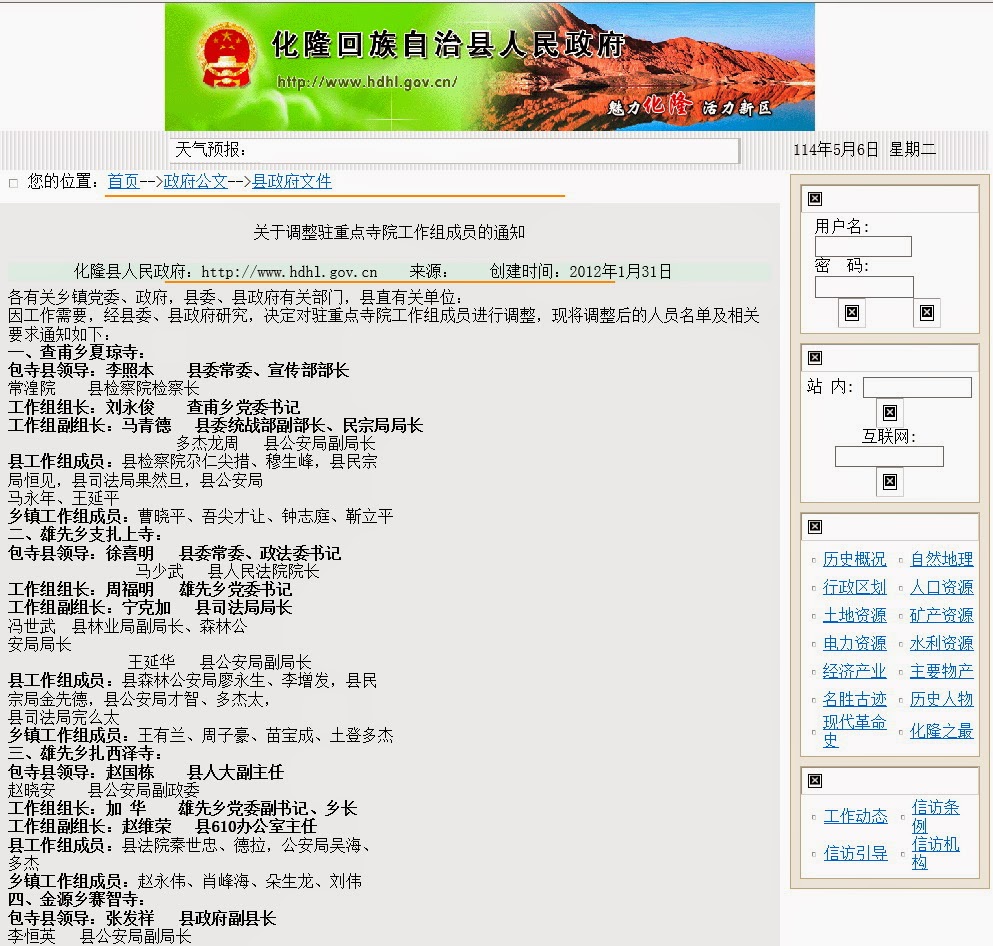
High Peaks Pure Earth has translated a blogpost by Woeser written on May 6, 2014 for the Tibetan service of Radio Free Asia and published on her blog on May 23, 2014.
In her previous week’s blogpost, “The Consequences of ‘Monastery Work Groups’ Being Stationed Inside Jhapa Monastery”, Woeser wrote about the work groups that are stationed by the local governments in monasteries.
In this week’s post, Woeser looks at a notice that was issued in 2012 in a single Autonomous County in Amdo, nowadays in Qinghai Province, Bayen County, known in Chinese as Hualong.
“Learning About ‘Monastery Work Groups’ Through A ‘Notice'”
By Woeser
On January 1, 2012, the government of the Bayen Autonomous County in Tsoshar Prefecture, Qinghai Province, issued the “Notice on the Adjustment of Work Group Personnel Stationed in Key Monasteries” on its official website.
This notice was an important text, not only determining the scope of “monastery work groups”, but also disseminating the following information:
1. Starting from October 2011, the Tibet Autonomous Region (TAR) has sent out work groups to be stationed in over 1700 monasteries and over 5400 villages of the autonomous region, encompassing a total of 30,000 cadres. To date, already the third batch has been sent out. But the Bayen County government emphasises that work groups have not only been sent to monasteries within the TAR. Bayen itself belongs to the Tibetan Amdo Province. Historically, it has, however, constantly been occupied by Hui people and in September 1949, following the CCP’s ethnic policies of dividing and conquering, the “Bayen Huizu Autonomous Region” was established, which includes five Tibetan townships.
2. The notice states that there exist eight “monastery work groups”, stationed in the eight most important Gelugpa Buddhist monasteries of Bayen County: Jakhyung Monastery, Detsa Trashi Monastery, Tashitse Monastery, Serdi Monastery, Dentig Monastery, Osa Monastery, Kaligang Monastery, and Yutsa Monastery. The most famous ones are Jakhyung Monastery with an over 700-year-long history and Dentig Monastery, the cradle of the second diffusion of Buddhism.
3. The so-called “work” carried out in the monasteries is evidently the most important government work. “The monastery work groups” are made up of cadres from 610 offices of important government departments, among others from the Security Bureau, the Prosecutorial Office, the Court of Law, the Judicial Department, the Forestry Department, the United Front Work department and the department for Ethnic and Religious Affairs as well as township-level cadres. Each work group encompasses between 12 and 16 people, with a total of 106. And this evidently only refers to the eight most important monasteries within this county.
So, have there been any events in recent years that the Bayen County government has labelled as “separatist movements” and that require stabilisation?
According to what I wrote in the book “The Snow-Lion Roaring in the Year of the Mouse”, a chronicle of the events in Tibet of March 2008:
March 10, 2008: Over 60 monks carried out peaceful demonstrations, holding up portraits of the Dalai Lama, and shouting slogans requesting freedom at Detsa Trashi Monastery in Bayen Huizu Autonomous County, Qinghai province; they were dispersed by local military troops. Subsequently, over 400 monks and ordinary people held a ceremony at the mountain behind the monastery, burning incense and praying.
In a different book, “Chronology and Accounts of Tibetan Self-immolations”, I wrote:
In the evening of February 24, 2013, the 21-year-old farmer, Phagmo Dundrup, self-immolated at Jakhyung monastery in Tsapuk township to express his resistance. As he was taken to Xining City hospital by his family, he was snatched by military police and passed away shortly after. Phagmo Dundrup’s family and close friends were summoned, his home was searched and all “benefits for the people” were cancelled, including loans and subsidies.
Since this was the place where Phagmo Dundrup self-immolated, let me recount some of the “work group stories” from Jakhyung monastery. Once, the “work group” gathered all monks and emphasised the need for “patriotism and stability” and to “oppose self-immolations”; they also put up “anti-self-immolation notices”, asking monks and ordinary people to celebrate Tibetan New Year. Additionally, all monk residences were searched and the portrait of the Dalai Lama enshrined in the centre of the main Buddhist hall was confiscated. After the self-immolation incident, the head of the County Department for Ethnic and Religious Affairs, Ma Qingde, urged the work groups to increase the frequency of such meetings, emphasising the fact that self-immolations are “violating the law”. A group of monks were summoned by the police. Over 40 military police were stationed around the monastery, often searching monks and residences, disallowing them to visit the family of the self-immolator or pray to express their grievances, threatening that anyone disobeying would be sentenced to 15 to 20 years in prison.
May 6, 2014





Follow Us!